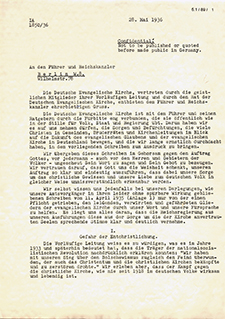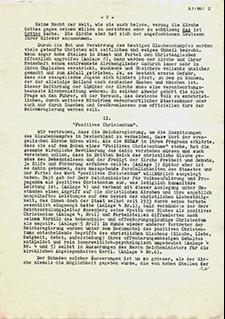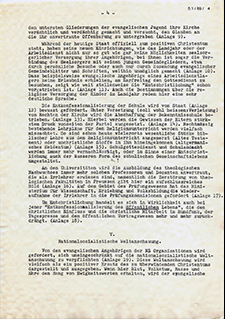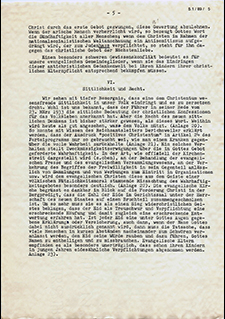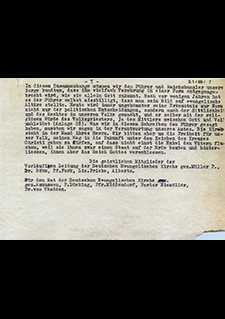The Provisional Church Government’s Memorandum
The Nazi regime attempted to drive the churches out of public life from 1935 onward. It aimed to deprive the churches of any influence on society and to disband their organizations. They were barred from the press and radio. The church’s own publishing outlets were subjected to heavy restrictions. The education of children and young people was taken away from the churches. High party and government officials made utterly disparaging remarks about Christianity and the church in their propaganda speeches. At the same time, a number of new laws put the Protestant church under increasingly strict state supervision.
The Protestant church protested against this development repeatedly. One document however stands out from all of the protests: The “Provisional Church Government’s Memorandum to Hitler” from the end of May 1936.
In this memorandum, the leaders in charge of the radical Confessing Church also dared to criticize social development in the Nazi state beyond the sphere of the church. No other protest from the Protestant church’s leadership so clearly took a stand against anti-Semitism, the existence of concentration camps and the Gestapo’s arbitrary use of power.
Criticizing the Nazi state did not come easily to the leaders of the Confessing Church, however. Most of them had allowed themselves to get carried away by national euphoria and partially agreed with Nazi aims. Moreover, a wave of arrests had befallen the Confessing Church just a year before after a similar protest.
Hence, the memorandum underwent a difficult writing process, over the course of which its political statements were increasingly toned down. Several times, it was doubtful whether the memorandum would come about at all. Driven by a deep sense of Christian responsibility, the Confessing Church ultimately brought itself to send the memorandum on to Hitler after all.
Hitler however was neither willing to take advice from the Confessing Church nor moved to change his course. It did not even receive a reply and therefore planned to apprise congregations of the originally strictly confidential memorandum addressed only to Hitler in a pulpit announcement.
The publication of the memorandum in the “New York Herald Tribune” and several European newspapers disrupted this situation. Despite all of the precautions taken by the Confessing Church, a copy of the memorandum had reached foreign countries through an indiscretion in its own ranks. Its publication in foreign newspapers had disastrous consequences: The Gestapo made several arrests and hauled the detainees off to Sachsenhausen concentration camp.
Friedrich Weissler, a jurist and employee of the Provisional Church Government, was hit hardest. Weissler was brutally murdered in Sachsenhausen in February of 1937. The radical Confessing Church was identified as an enemy of the state once and for all after the memorandum. It was also isolated within the Protestant church. Even the moderate faction of the Confessing Church distanced itself from the Provisional Church Government.
It is all the more remarkable that the radical Confessing Church found the courage to adhere to its plan of a pulpit announcement. This pulpit announcement was read aloud at many church services in the summer of 1936 despite the government ban.
Following its experiences with the memorandum, the Confessing Church never again dared to address the overall social situation under National Socialism beyond criticizing the constraints on the Christian faith. Almost without exception, later protests from church governments also remained confined to the church sphere until the collapse of National Socialism.
Source / title
- ©Landeskirchliches Archiv Bielefeld, 5, 1/89

